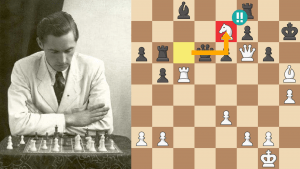Don't Play a Move If You Can't Back it Up!
Misspumkin (1895) – Darkschyte (1586), Chess.com 2012
1.d4 Nf6 2.c4 g6 3.Nf3 Bg7 4.Nc3 O-O 5.e4 d6 6.h3!?
Darkschyte said, “I think it’s not pleasant for him to meet …Bg4 but it wasn’t necessary to create that weakness, because …Bg4 its not particularly dangerous in this line.”
This little pawn move (I always referred to it as the Makogonov Variation [though that name usually refers to h3 with white's Knight still on g1], while Watson calls it the Bagirov Variation... when it comes to things like this, put your money on Watson.) has been (and is still being) used by many strong grandmasters. The ideas behind it are clear: it prepares Be3 (since …Ng4 is no longer possible), and also eyes a potential kingside expansion via g2-g4.
6…c6
6…Na6 has been played by Kasparov and Topalov, while 6…c5, 6…Nbd7, 6…Nc6, and even 6…a6 are also common replies. 6…e5 is black’s most popular move, when a key (and rather odd looking) mainline goes 7.d5 Nh5 8.Nh2. Here’s a sample of what occurs after 8.Nh2:
1.d4 Nf6 2.c4 g6 3.Nc3 Bg7 4.e4 d6 5.Nf3 0-0 6.h3 e5 7.d5 Nh5 8.Nh2 Qe8 9.Be2 Nf4 10.Bf3 f5 11.g3 Nxh3 12.Bg2 f4 13.Nf3 g5 14.Bxh3 (14.Rxh3!? g4 15.Rh1 gxf3 16.Qxf3 Qg6 17.Bh3 Na6 [17…fxg3 18.Qxg3 Qxg3 19.fxg3 Bxh3 20.Rxh3 Nd7 makes more sense, though white’s superior Bishop gives him a small edge] 18.Bxc8 Raxc8 19.gxf4 exf4 20.Bd2 Rce8 21.0-0-0 Kh8 22.Rdg1 and Black lost quickly in V. Zakharstov (2527) – D. Pudovkin, Stepanov Memorial 2001) 14…g4 15.Nh4 gxh3 16.g4 f3 17.Nf5 h5 18.Qxf3 hxg4 19.Qxg4 Bxf5 20.exf5 Qd7 21.Bh6 Rf7 22.Ke2 Rxf5 23.Rag1 Rf7 24.Rxh3 Na6 25.Qxd7 Rxd7 26.Rhg3 Kh7 27.Bxg7, 1-0, T. Polak (2483) – M. Schlosser (2335) [E90], Austria 2006.
I decided to give this line a try way back in 1981. Here are a couple examples:
1.d4 Nf6 2.c4 g6 3.Nc3 Bg7 4.e4 d6 5.Nf3 0-0 6.h3 Nbd7 7.Be3 e5 (7…c6 8.Be2 e5 9.d5 cxd5 10.cxd5 Nh5 11.g3 f5 12.exf5 gxf5 13.Ng5 f4 14.Ne6 Qf6 15.gxf4 Nxf4 16.Rg1 Nxe6 17.dxe6 Nb6 18.e7 Re8 19.Ne4 Qe6 20.Nxd6 Rxe7 21.Bxb6 Kh8 22.Bc4 Qf6 23.Bd8 Bg4 24.Bxe7, 1-0, Silman – S. Scheiner [E90], San Francisco 1981) 8.d5 Nc5 9.Nd2 a5 10.a3 Ne8 11.b4 axb4 12.axb4 Rxa1 13.Qxa1 Na6 14.Qa5 f5 15.Nb3 Nf6 16.Be2 Nxe4 17.Nxe4 fxe4 18.Nd2 c5 19.Qxd8 Rxd8 20.b5 Nb4 21.Bg5 Re8 22.Nxe4 Bf5 23.Nxd6 Ra8 24.0-0 b6 25.Nxf5 gxf5 26.Rd1 h6 27.Bh4 Ra7 28.Bd8 Bf8 29.Bxb6 Rb7 30.d6 Rxb6 31.d7 Be7 32.d8=Q+ Bxd8 33.Rxd8+ Kf7 34.Rc8 Nc2 35.Rxc5 Ke6 36.Rc8 Nd4 37.Bf1 Kd7 38.Rh8 Rg6 39.c5 Ne6 40.Rh7+ Kc8 41.b6, 1-0, Silman – E. Osbun, [E90], San Francisco 1981.
7.Be3 Qe8!?
Darkschyte said, “So the queen does not need to guard the c7-square, also preparing e5 and I’m not really behind in development.”
I’ve never seen this move played here before. The reason is that there’s no need for it since …e7-e5 is easy to achieve with more natural moves (7…Nbd7 is obvious). In fact, if you want to play …e7-e5, what could be more natural than 7…e5, just doing it? White gets absolutely nothing after 8.dxe5 (the position after 8.d5 has scored quite well for White) 8…dxe5 9.Qxd8 (9.Nxe5 Qa5 is annoying) 9…Rxd8 10.Nxe5 Nxe4 11.Nxe4 Bxe5 12.Bg5 Bxb2 13.Rb1 Re8.
8.Rc1?!
Darkschyte said, “Ideal place for the rook in such positions.”
Why is this ideal? If White decides to go King hunting with g2-g4, what would Rc1 achieve? If White wants to play on the queenside, are you sure that c1 is the best square for the Rook? And last (but certainly not least), if White wants to castle queenside… well, he can’t!
No, 8.Rc1 doesn’t make sense to me. Instead, 8.Be2 develops, prepares to castle, and after a move like Nd2, keeps black’s Knight off the h5-square. See the difference? I can tell you why 8.Be2 is good. But you can’t tell me why 8.Rc1 deserves to exist. Make moves that have concrete reasons to back them up.
8…e5 9.d5 c5!?
Why is white’s Rook on c1? What future does it have on that square? Also, you played …c6 but didn’t make any real use of it. If you want to play …e5, you should really do so on move six.
10.Qd2
I’m not enthralled by this move either. Normally I would play something like 10.Nd2 here, but after 10…Nh5 11.g3 Na6 12.Be2 Nhf6 13.g4 we have Black wondering why his Queen is on e8, and White wishing that he never moved his Rook to c1 since castling queenside is something White might very much like to do here.
10…Nbd7 11.Bh6
Amateurs love this idea, and sometimes it’s excellent. However, here black’s Bishop isn’t particularly active so White shouldn’t be rushing to exchange it off.
11…Nh5
Darkschyte said, “The point is that if he plays g4 I go with …Nf4 sacrificing a pawn to keep my dark squared bishop if he wants that pawn.”
Black is talking about a thematic KID idea: 12.g4 Nf4 13.Bxf4 exf4 14.Qxf4 f5 (14…Ne5!?) when black’s control over the dark-squares mixed with white’s centrally placed King leaves Black with more than enough compensation for the pawn.
12.Nb5?!
Darkschyte said, “I think not the best move as that threat can be met quite easily.”
12…Qe7 13.Be2 a6
A good move, though 13…Nf4! (offering a pawn for dark-square domination) is even better.
14.Nc7??
Darkschyte said, “Now he loses the knight by force.”
I wonder what White was thinking? You can’t expect your opponent to give you a piece just because you’re threatening it! In fact, you need to always expect him to defend properly. This means, if you threaten something, you need to ask the following question: “He will defend it. When he does, what have I gained by my attack?”
Sadly, in this game White plops his Knight deep into enemy territory so he can attack black’s Rook, with no concern as to whether that Knight will make it out alive. Now a piece is lost and the game is, for all intents and purposes, over. Of course, the sane 14.Nc3 had to be played.
14…Rb8
14…Ra7, intending …b6 followed by …Rxc7, also was winning.
15.Bxg7 Nxg7?
Darkschyte said, “My idea after taking the c7-Knight was to play …f5, but it was a dream because of the obvious Qh6-Ng5 so I prepared myself to defend a bit after winning the Knight.”
Much simpler was 15…Kxg7 when Qh6 isn’t possible anymore and Black (who will win the c7-intruder) should win without any muss or fuss.
16.Qh6
Also hopeless is 16.Qg5 Qxg5 17.Nxg5 b6 18.Bg4 Rb7 19.Bxd7 Bxd7 20.Nxa6 Ra7 and the Knight will finally meet its fate.
16…Nf6
Darkschyte said, “This protects h7 and also unleashes a discovered attack against white’s knight.”
17.Ng5 Qxc7 18.g4
A hard move to understand. White’s main target is the f6-Knight since it’s defending h7. With that in mind, 18.0-0 followed by f2-f4 cracking open the f-file and in an effort to reach the f6-Knight.
Note that tossing a pawn in the enemy King’s direction (18.g4) isn’t attacking. A proper attacking move has to have a point, based on the needs of that particular situation. 18.0-0 followed by f2-f4 has a clear point, and should have been tried.
18…Qa5+ 19.Rc3 Qb4
Darkschyte said, “This maneuver was to create some counterplay in the queenside, but obviously I should be taking care in the kingside because the pawn storm looks menacing as he has a rook on the h-file.”
Going after active counterplay in this fashion is fine, since the “menacing” h3-h4-h5 is pie in the sky: 20.h4 Qxb2 21.Rg3 (21.Rf3 Bxg4 22.Rxf6 Qxe2 mate; 21.h5 Qxc3+ 22.Kf1 Qc1+ 23.Kg2 Qd2 24.hxg6 fxg6 25.Nxh7 Qxe2 [25…Qxh6 was also easy, but 25…Qxe2 demonstrates the impotence of white’s attack] 26.Nxf8 [26.Ng5 Qxf2!] and now Black wins with any sane move - 26…Kxf8, 26…Bxg4, 26…Nxg4, 26…Nxe4, 26…Qxf2+ 27.Kxf2 Nxg4+, etc.) 21…b5 22.h5 bxc4 23.hxg6 fxg6 24.Nxh7 Nxg4 and white’s attack has failed.
20.0-0
Darkschyte said, “I think that was bad, that rook was great on the h-file.”
As the analysis showed, 20.h4 was nonsense, so getting the King to safety and preparing the f2-f4 idea makes perfect sense. Also worth a shot was 20.f4 Qxb2 21.Rf3. Here’s a sample of bad defense by Black leading to White storming back into the game: 21…Qb1+ 22.Bd1 Qb4+ 23.Kf1 exf4 24.Rxf4 Nge8 25.Kg2 Qxc4 26.Rhf1.
20…Qxb2 21.Re3
21.Rf3 Nge8.
21…Bd7 22.h4?
Ignoring my “go after f6!” formula! White’s last chance was 22.f4! when White will be able to create some serious threats (even if white’s dead lost, he’s still posing his opponent real problems, which is all you can ask after tossing a piece away for nothing): 22…Qd4 (22…exf4 23.Ref3 Rfd8 [23…Qxe2 24.Rxf4 Bf5! might be black’s best] 24.Rxf4 Nge8 25.R1f2 and it’s not possible to laugh at white’s attack anymore!) 23.fxe5 Qxe3+ 24.Kh1 Qxe2 25.exf6 (25.Rxf6!?) 25…Qxf1+ 26.Kh2 Qf2+ and Black has to take a draw by perpetual check.
22…b5 23.h5 bxc4 24.hxg6 fxg6 25.Rf3 Nge8
Darkschyte said, “It was necessary: 25...Qxe2?? 26.Rxf6 Rxf6 27.Qxh7+ Kf8 28.Qh8+ Ke7 29.Qxg7+ bringing White back to life.”
Actually, after your 25...Qxe2 26.Rxf6 Rxf6 27.Qxh7+ Kf8 28.Qh8+ Ke7 29.Qxg7+ black’s still much better after 29…Kd8 30.Qxf6+ Kc7. Of course, compared to what White had earlier, this is heaven.
However, your analysis is flawed since 25…Qxe2 (which you attach two question marks to) is actually best (your 25…Nge8 is also a winner): 26.Rxf6 Qxg4+! 27.Kh2 Qh5+ 28.Qxh5 Nxh5 and White can resign.
26.Kg2?
White’s lost, but he might as well have played 26.Bxc4, winning a pawn instead of losing a piece (a 4 point swing!).
26…Qxe2 27.Rh1 Bxg4! 28.Ne6??
Darkschyte said, “maybe the final trick as he threatens mate in one.”
28…Qxf3+ 29.Kf1 Bxe6
29…Rb1+ mates after 30.Qc1 Rxc1.
30.dxe6 Qxf2+, 0-1. 30…Rb1+ still led to a quick mate.
~ Lessons From This Game ~
* Opening moves need to blend together and work for the same goals. If your opening moves aren’t doing that, odds are you’re doing something wrong.
* If you can’t verbally back up your move with ideas based on the position (and not based on random emotion), don’t play it!
* You can’t expect your opponent to give you a piece just because you’re threatening it! In fact, you need to always expect him to defend properly. This means, if you threaten something, you need to ask the following question: “He will defend it. When he does, what have I gained by my attack?”






